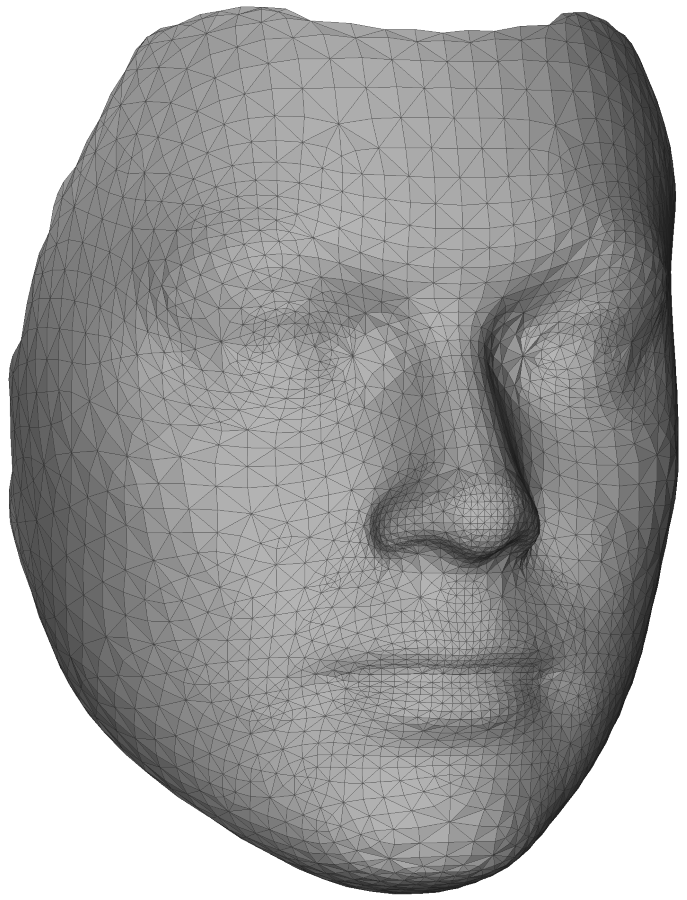eos is a lightweight 3D Morphable Face Model fitting library that provides just the bare minimum to load a model and perform camera and shape fitting. It's written in modern C++11/14.
At the moment, it mainly provides the following functionality:
- MorphableModel class to represent a 3DMM (using OpenCVs
cv::Mat) - Our low-resolution, shape-only 3D Morphable Face Model (share/sfm_shape_3448.bin)
- Camera pose estimation, implementation of:
- the Gold Standard Algorithm for estimating an affine camera matrix, from Multiple View Geometry, Hartley & Zisserman
- a non-linear algorithm that directly estimates the pose angles and camera translation
- Shape fitting, implementation of the linear shape-to-landmarks fitting of O. Aldrian & W. Smith, Inverse Rendering of Faces with a 3D Morphable Model, PAMI 2013
- Expression fitting, and 6 linear expression blendshapes: angry, disgust, fear, happy, sad, surprised.
- Isomap texture extraction to obtain a pose-invariant representation of the face texture.
- Tested with the following compilers: >=gcc-4.8.4, >=clang-3.5, Visual Studio 2015
- Needed dependencies for the library: Boost system (>=1.50.0), OpenCV core (>=2.4.3)
To use the library in your own project, just add the following directories to your include path:
eos/includeeos/3rdparty/cereal-1.1.1/includeeos/3rdparty/glm-0.9.7.0
- Needed dependencies for the example app: CMake (>=2.8.10), Boost system, filesystem, program_options (>=1.50.0), OpenCV core, imgproc, highgui (>=2.4.3).
To build:
git clone https://github.com/patrikhuber/eos.git
mkdir build && cd build # creates a build directory next to the _eos_ folder
cmake -G "<your favourite generator>" ../eos -DCMAKE_INSTALL_PREFIX=../install/`
make && make install # or open the project file and build in an IDE like Visual Studio
If some dependencies can't be found, copy initial_cache.cmake.template to initial_cache.cmake, edit the necessary paths and run cmake with -C ../eos/initial_cache.cmake.
The fit-model example app creates a 3D face from a 2D image.
After make install or running the INSTALL target, an example image with landmarks can be found in install/bin/data/. The model and the necessary landmarks mapping file are installed to install/share/.
You can run the example just by running:
fit-model
Or, by manually specifying the face model, landmark-to-vertex mappings, an image and its 2D landmarks:
fit-model -m ../share/sfm_shape_3448.bin -p ../share/ibug2did.txt -i data/image_0010.png -l data/image_0010.pts
The output is an obj file with the shape and a png with the extracted isomap. The estimated pose angles and shape coefficients are available in the code via the API.
See examples/fit-model.cpp for the full code.
The library includes a low-resolution shape-only version of the Surrey Morphable Face Model. It is a PCA model of shape variation built from 3D face scans. It comes with uv-coordinates to perform texture remapping.
The full model will be available soon too via academic licencing.
Doxygen: http://patrikhuber.github.io/eos/doc/
The fit-model example and the Namespace List in doxygen are a good place to start.
This code is licensed under the Apache License, Version 2.0. The 3D morphable face model under share/sfm_shape_3448.bin is free for use for non-commercial purposes. For commercial purposes, contact the Centre for Vision, Speech and Signal Processing.
Contributions are very welcome! (best in the form of pull requests.) Please use Github issues for any bug reports, ideas, and discussions.
If you use this code in your own work, please cite the following paper: A Multiresolution 3D Morphable Face Model and Fitting Framework, P. Huber, G. Hu, R. Tena, P. Mortazavian, W. Koppen, W. Christmas, M. Rätsch, J. Kittler, International Conference on Computer Vision Theory and Applications (VISAPP) 2016, Rome, Italy [PDF].


